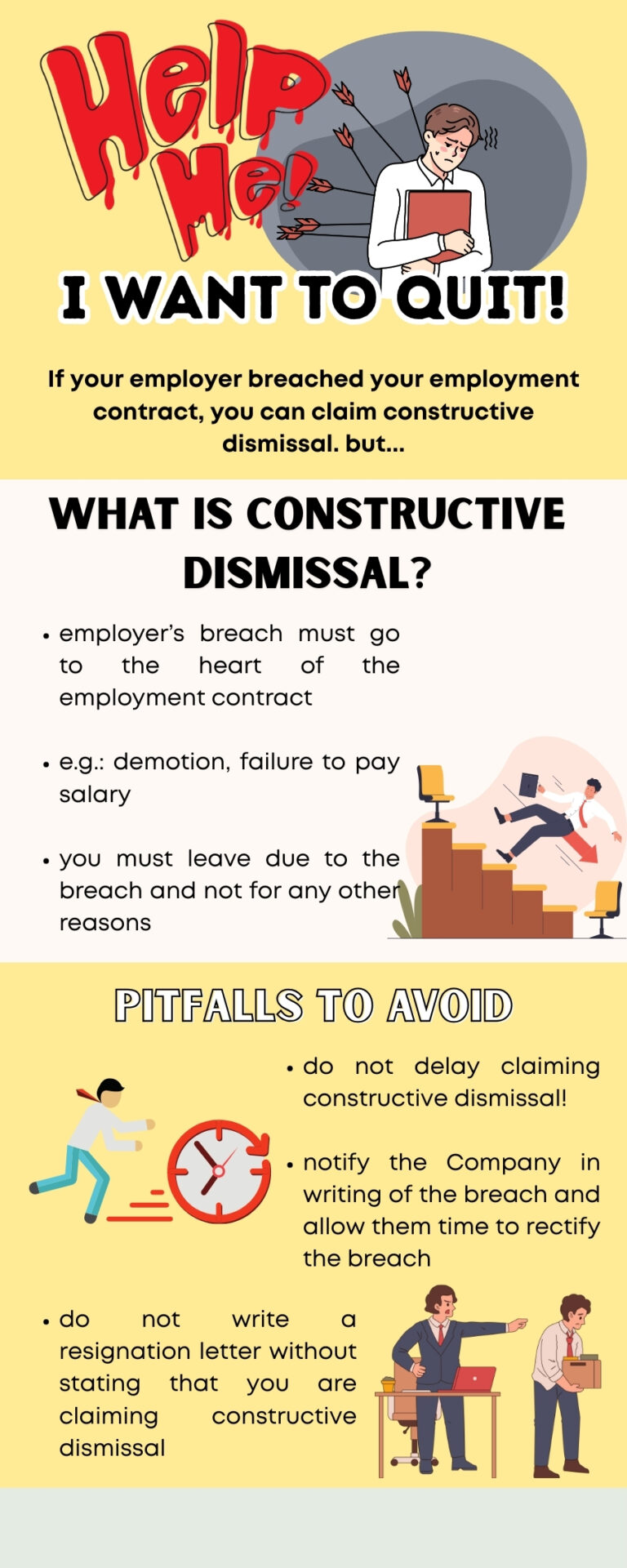HELP ME! I WANT TO QUIT!

Have your employer made working so unbearable that you want to quit? You may be able to claim constructive dismissal.
What is constructive dismissal?
- Constructive dismissal is when the employee terminates the employment relationship (i.e. resign) as a result of a breach of contract by the employer.
- Although the employee is the one who quits, they can claim to have been “constructively” dismissed by the employee if the employer breached an important term of the contract, hence the employee has been dismissed.
- The employee can then lodge a complaint to the Industrial Relations Department that they have been dismissed without just cause and excuse.
- Therefore, constructive dismissal is an indirect situation where no termination letter was issued but by virtue of the employer’s conduct, they have terminated the employment contract.
However, there is a legal threshold to satisfy before an employee can claim constructive dismissal. Otherwise, the Court would have created a situation where employees can just walk off and claim constructive dismissal once they feel like the employer has been unreasonable.
What then is the legal test to be satisfied to claim constructive dismissal?
- There must have been a breach of contract by the employer;
- The breach must be significant enough, which goes to the ‘root’ of the employment contract;
- The employee must leave due to the breach and not for any other reasons; and
- The employee must not delay leaving as a result of the breach.
What breach is serious enough to justify claiming constructive dismissal?
- Failure to pay salary
- Demotion without basis or with bad intention, such as reduction in job scope, change of reporting line, reduction of benefits, change of office space to a small room (this should be distinguished from employees who have committed misconduct and the employer is demoting them as a form of disciplinary action)
- Unsafe workplace (including failure to address the employee’s complaints such as sexual harassment)
- Harassment and discrimination such that it made it unbearable for the employee to continue working
Common mistakes that employees make when claiming constructive dismissal are:
- Delay claiming constructive dismissal – this will make it harder to prove that you left as a result of the breach!
- Resigning immediately after the “breach” has occurred – the employee should first write to the employer regarding the breach and allow the employer some time to rectify the breach before resigning. Otherwise, the Court may hold that the employee has “jumped the gun”.
- Submitting a resignation letter without stating that they are claiming constructive dismissal – should the employee submit a resignation letter stating that they are grateful to the company, then later claim constructive dismissal by lodging an unfair dismissal complaint, the employee’s claim for constructive dismissal may not seem genuine. So if you want to claim constructive dismissal, state the what happened and the reason(s) which caused you to claim constructive dismissal in your letter to the employer.
How can we help?
For employers:
- we can go through the documents and facts, then advise whether the above legal test is satisfied and to guide you on the next steps available to you
- inform you of the estimated maximum financial exposure
- advise you at the conciliation meeting stage and assist to fill up the forms
- represent you in the Industrial Court
For employees:
- go through the documents and facts, then advise you on your next steps
- drafting letters to the Company to claim constructive dismissal or any communication with the employer
- assist you with the lodging of the unfair dismissal complaint at the Industrial Relations Department and advising you on the same
- representing you in the Industrial Court